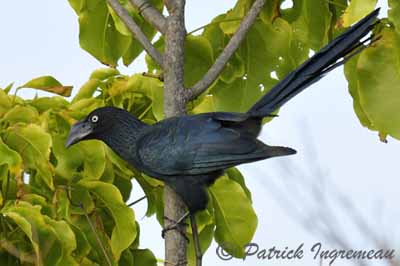
Greater Ani
Crotophaga major
Cuculiforme Order – Cuculidae Family
BIOMETRICS :
Length : 46-48 cm
Weight : M : 165 gr – F : 145 gr
DESCRIPTION:
Greater Ani is a very gregarious species, often seen in noisy groups. It is larger than other anis species which have dark eyes.
Adult male has glossy dark blue-black plumage overall, with conspicuous green feather edges on neck, upper back and shoulders.
The upperwing shows greenish iridescence, mainly on the flight feathers. The long, rounded tail has purplish gloss.
The head is bluish-black. The massive black bill shows arched ridge at base of the upper mandible. The eyes are yellowish-white. Legs and feet are black.
Both sexes are similar.
Fr: Ani des palétuviers
All: Riesenani
Esp: Garrapatero Mayor
Ital: Ani maggiore
Nd: Grote Ani
Port: Anu-coroca
Photographs by Patrick Ingremeau
TAMANDUA
Text by Nicole Bouglouan
Sources:
HANDBOOK OF THE BIRDS OF THE WORLD vol 4 by Josep del Hoyo-Andrew Elliott-Jordi Sargatal - Lynx Edicions - ISBN: 8487334229
A GUIDE TO THE BIRDS OF COLOMBIA by Steven L. Hilty and William L. Brown
Princeton University Press – ISBN 069108372X
Arthur Grosset's Birds (Arthur Grosset)
SORA Searchable Ornithological Research Archive (Blair O. Wolf)
Wikipedia (Wikipedia, The Free Encyclopedia)

The juvenile has brown eyes and the bill is less developed than in adults.
Greater Ani has a bad odour, mainly when they are pressed against each other at roost.
VOICE: SOUNDS BY XENO-CANTO
Greater Ani is very noisy. It utters a variety of croaks, grating calls, hisses and whirring sounds. It also gives guttural gobbling “kro-koro” rapidly repeated and melodious.
Alarm call is a harsh rasping note, repeated several times.
HABITAT:
Greater Ani lives in moist forest, flooded tropical forest, gallery-forest, thickets and wooded areas along rivers and in thick vegetation. It is also found in swamps, mangroves, lake margins, marshes and usually in vegetation above water.
This species may move into clearings but not too much into forest. It can be seen in villages. It occurs from the lowlands up to 500 to 800 metres of elevation, but in Colombia and Bolivia, it occurs up to 2500 metres.
RANGE:
Greater Ani lives from Panama and Trinidad, throughout tropical South America to northern Argentina.
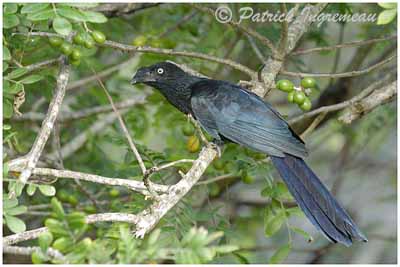
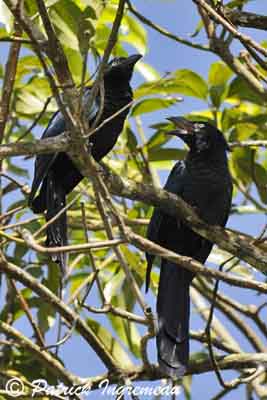
BEHAVIOUR:
Greater Ani is often seen in small groups hidden into vegetation. If they are disturbed, they fly out one after one to other thick vegetation patch.
Greater Ani feeds mainly on insects, but also on varied other items such as lizards, fruits, berries and seeds. It usually feeds in flocks, as on the ground or in the canopy, near water. The birds stay in contact by squeaky calls.
These birds live in groups almost all year round. They defend their territory against other groups with harsh calls. They roost together, often pressed against each other.
By feeding in wet vegetation, the Greater Ani has to dry its plumage, spreading wings and tail, and fluffing up the feathers in the sun. This bird is also able to low its body temperature at night, in order to adapt to cool weather conditions.
Greater Ani prefers the wet forest edges for foraging. Its large bill is used as a wedge when it moves among large wet leaves.
When it progresses in trees, the Greater Ani performs jerky movements. It is clumsy while it flutters through the bushes and trees. Its wings and the waving tail flush insects in the thick vegetation.
Greater Ani is resident in its range, only performing some local movements.
FLIGHT:
Greater Ani is awkward and clumsy when it moves. Its wings and tail seem to be independent of the body, giving jerky movements.
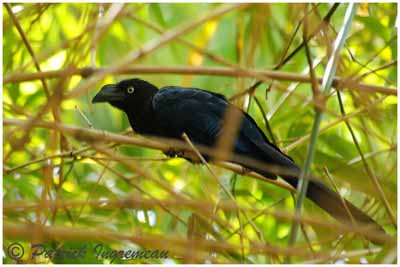
REPRODUCTION:
Breeding season varies, according to the location, with a peak in April-May to September-December.
Greater Ani nests in loose colonies and it is cooperative breeder. Groups are formed by several pairs.
The nest is situated in trees or shrubs, at about 3 to 5 metres above the ground, and often above the water. It is made with sticks, and the interior is lined with leaves. Sticks are broken from trees with the bill. The bulky nest is kept up during the incubation, with green leaves regularly added.
Several females lays in the same nest, and each female may lay 5 to 7 eggs. Clutches are usually up to 2 to 5 eggs, but up to 6 eggs include several females. The eggs are greenish-blue, covered by thin, white layer of calcareous material.
Incubation is shared by both sexes, and the young of the first brood may feed the chicks of the second clutch.
After fledging and when independent, the young leave the group and the territory. Only a few birds remain in the group.
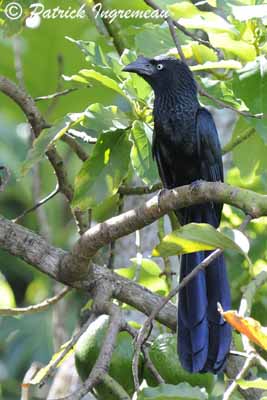
DIET:
Greater Ani feeds mainly on insects such as grasshoppers, caterpillars, beetles, and also spiders. It may take small lizards, and consumes fruits and berries, and the seeds of Euphorbia.
PROTECTION / THREATS / STATUS:
Greater Ani is fairly common in its range. Thanks to its very bad odour, this bird is rarely killed by cats or humans.
This species is not threatened at this moment.